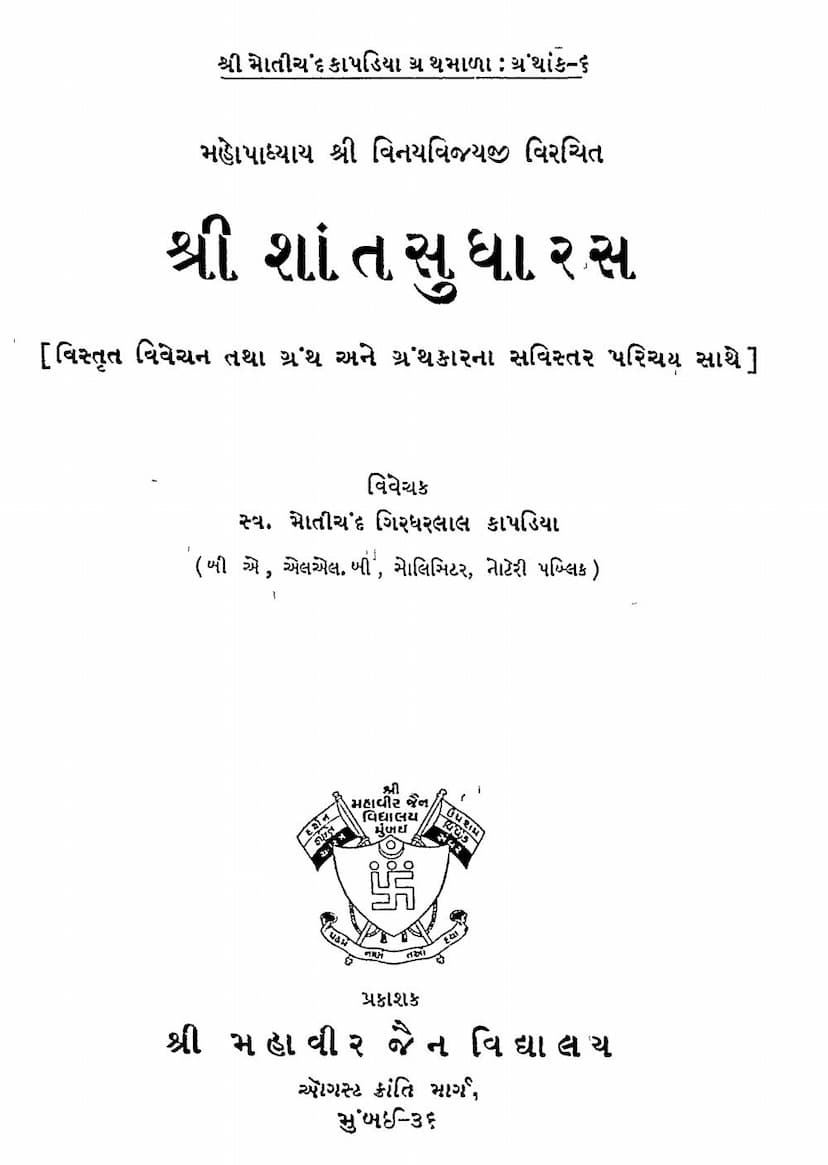Shant Sudharas
Added to library: September 2, 2025

Summary
This comprehensive summary outlines the Jain text "Shant Sudharas" by Motichand Girdharlal Kapadia, published by Mahavir Jain Vidyalay. The book is a detailed commentary on Mahopadhyay Shri Vinay Vijayji's "Shri Shant Sudharas," a poetic work exploring sixteen sentiments crucial for spiritual progress.
The text meticulously analyzes twelve primary sentiments (Bhavanas) such as impermanence, refugelessness, worldly cycle, oneness, otherness, impurity, influx of karma, restraint, and annihilation. It also delves into four higher sentiments: friendliness, joy, compassion, and equanimity. The commentary, authored by the late Motichand Girdharlal Kapadia during his imprisonment, emphasizes the profound philosophical and devotional aspects of these sentiments, highlighting their role in spiritual awakening and liberation.
Key aspects covered in the summary include:
- The Original Text: "Shri Shant Sudharas" by Mahopadhyay Shri Vinay Vijayji, described as a sweet poetic work and a great song celebrating the sixteen Bhavanas.
- The Commentary: Written by Motichand Girdharlal Kapadia, it provides extensive analysis and introduction to the text and its author.
- Structure of the Commentary: The commentary is divided into sections covering the text's planning, the twelve Bhavanas, the necessity of these Bhavanas in the current era, their categorization, the four higher Bhavanas, introspection, and an overall evaluation of the work's language, clarity, and presentation.
- Author Introduction: A detailed biography of Mahopadhyay Shri Vinay Vijayji, including his time period, influences, and extensive literary contributions, is provided.
- Historical Context: The book places Vinay Vijayji's work within the socio-political and religious landscape of 17th-18th century India, touching upon the prevailing conditions and intellectual currents.
- Literary Merit: The summary praises the text's lyrical quality, its use of devotional verses set to traditional Indian ragas, and its ability to evoke profound spiritual emotions.
- Philosophical Depth: The commentary highlights the text's exploration of concepts like impermanence, the illusory nature of worldly attachments, the journey of the soul, and the path to self-realization, drawing connections to psychological principles and the need for suitable environmental preparation for spiritual growth.
- Practical Application: The text emphasizes the importance of these Bhavanas for introspection, decision-making, and ultimately, achieving peace and liberation from the cycle of rebirth. It stresses that true happiness lies in self-reliance and inner spiritual pursuits, rather than fleeting material pleasures.
- Support and Publication: The summary acknowledges the support received from various Jain organizations and individuals for the publication of this valuable work, noting its multiple editions and its significance in Jain literature.
- Specific Bhavanas: The summary details the essence of each Bhavana, such as the impermanence of the physical body and worldly possessions, the unreliability of external support, the cyclical nature of existence, the uniqueness of the soul, the impurity of the body, the mechanisms of karma (influx, restraint, and fruition), the importance of righteous conduct, the understanding of the worldly system, and the rarity of achieving spiritual knowledge.
- Comparison with Gitas: The text also draws a comparison between "Shant Sudharas" and Jayadeva's "Gita Govinda," noting that while both are musically composed, "Shant Sudharas" focuses on spiritual detachment, whereas "Gita Govinda" centers on devotional love and worldly pleasures.
In essence, "Shant Sudharas," as presented through this commentary, serves as a profound guide for spiritual seekers, offering timeless wisdom on self-reflection, detachment, and the pursuit of inner peace and ultimate liberation. The commentary by Motichand Girdharlal Kapadia is lauded for its scholarly depth and its accessibility to readers seeking to understand these spiritual principles.